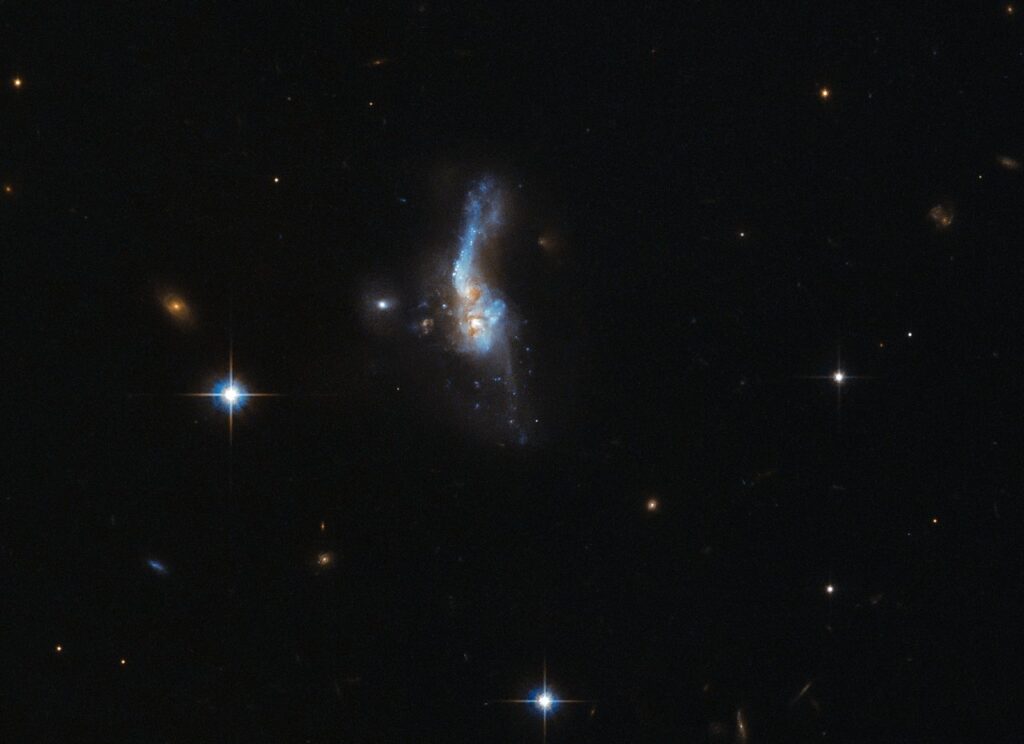A team of astronomers led by SRON has observed ten times more hyper luminous galaxies in the infrared than stars can produce according to the models. If the theory is correct, it means that stars alone cannot account for the brightness of the most luminous infrared galaxies. Publication in a special issue of Astronomy & Astrophysics. On ArXiv on November 18th.
After the Universe emerged from the Big Bang 13.8 billion years ago, galaxies filled with stars began to form relatively quickly around three billion years later. There was plenty of gas to go around, so a small portion of these early galaxies were able to grow into massive, hyper luminous galaxies, with a brightness of ten trillion suns. As the gas reserves grew empty with time, fewer galaxies could grow at a fast pace.
order of magnitude too many hyper luminous infrared galaxies
When astronomers observed the Universe with the infrared space telescope Herschel, they found that this theory largely checks out. However, in terms of absolute numbers it looked like there are over an order of magnitude too many hyper luminous infrared galaxies, both in the early Universe and more recent epochs. Unfortunately Herschel’s spatial resolution couldn’t resolve all individual galaxies, so they couldn’t say for sure.
LOFAR telescope
An international team of astronomers, led by Lingyu Wang from SRON and RUG, has now used the LOFAR telescope—with higher spatial resolution—to distinguish galaxies individually. They found that indeed there are over an order of magnitude more hyper luminous galaxies than the theory predicts, while bringing the uncertainty down to a factor two.
driving force
‘We are now studying what physical mechanisms can power such extreme galaxies,’ says Wang. ‘Are they powered by star formation or by supermassive black hole accretion? If powered by star formation, hyper luminous infrared galaxies would be forming stars at a few thousands solar masses per year. Theoretical models cannot produce that many galaxies forming stars at such extreme rates. So, an alternative scenario is that they are predominantly powered by accretion activity around the central black hole. We need more follow-up observations to study the true nature of these extreme objects.’
follow-up study
The team will perform this follow-up study using the Keck observatory. It will give them more accurate data on galaxies’ redshift and therefore their distance. Keck harbors an optical telescope, providing spectra. Astronomers deduce the redshift from spectra by looking at how many wavelengths the characteristic fingerprints have shifted.
Publication
L. Wang, F. Gao, P. N. Best, K. Duncan, M. J. Hardcastle, R. Kondapally, K. Małek, I. McCheyne, J. Sabater, T. Shimwell, C. Tasse, M. Bonato, M. Bondi, R. K. Cochrane, D. Farrah, G. Gürkan, P. Haskell, W. J. Pearson, I. Prandoni, H. J. A. Röttgering, D. J. B. Smith, M. Vaccari, W. L. Williams, ‘The bright-end of the infrared luminosity functions and the abundance of hyperluminous infrared galaxies‘, Astronomy & Astrophysics



